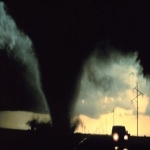As summer begins, there is a chance of developing severe weather. In the ideal world, we would hope to be at home and in the basement, however, this isn’t always the case. What are you supposed to do when you are working, outside in an open area, inside of a mobile home, in a house that has no basement, in a church, or even worse in a car?
Recently, we had severe thunderstorm and tornado warnings, during rush hour traffic. What is more scary than being in a car and hearing those sirens go off?
What are the signs of a tornado?
- Dark or green colored sky.
- Hail
- A low lying cloud, with rotation at the cloud base.
- A loud roar that sounds like a train, which does not stop like thunder would.

Types of Tornadoes and possible effects:
EF-O: (65-85 mph) Can pushing a moving car. Branches broken. Shingles ripped off of houses.
EF-1: (86-100 mph) Can lift a car off the ground. Mobile homes can become overturned. Windows broken. Roof damage.
EF-2: (111-135 mph) Roofs torn off. Homes can be shifted off their foundation. Mobiles homes destroyed.
EF-3: (136-165 mph) Entire stories of a house ripped off. Homes with weak foundations can be blown away.
EF-4: (166-200 mph) Well constructed homes are leveled. Cars can be thrown significant distances away.
EF-5: (>200 mph) Homes are destroyed. Cars can be thrown 100 yards or more. Trees are debarked.

Possible scenarios…..
Mobile homes: You should get out and go to the nearest sturdy building.
Outdoors: If possible, seek a sturdy shelter. If not, you should lie flat on your stomach, and face down. You should protect the back of your head with your arms. You should also avoids trees and cars, as they may fall on you. Try and go to the lowest level possible.
House/Office with no basement: Avoid windows and get to the lowest level possible. You should go underneath a stairwell, into the bathroom, or to a hallway with no windows. You should shield yourself with blankets and/or a mattress.
Car: The centers for disease control and prevention suggests “motorists seek shelter immediately.” If you are in your car and are around sturdy buildings, you should go to the nearest building (fast food restaurants, banks, gas stations, etc.) You should not hide underneath a overpass, as the winds can be worse. Also, you should not try and outrun a tornado in your car.
- If you see a tornado and there is nowhere to go, pull over, and try to get to a lower level than the road way. You should lie flat on your stomach, and face down. You should protect the back of your head with your arms.
- If the road is the lowest level, stay in your vehicle. Keep your seat belt on, and lower your head below the windows. Keep your head protected if possible.
Author: Darci Mertz
Sources:
http://www.srh.noaa.gov/hun/?n=efscale_explanation
http://www.spc.noaa.gov/faq/tornado/safety.html
What to do if a tornado hits while you are driving
http://www.accuweather.com/en/weather-glossary/tornado-safety-what-to-do-whil/10496166

